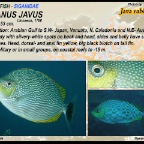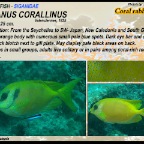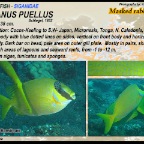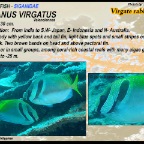Rabbitfish - Siganidae
RABBITFISH - SIGANIDAE
Rabbitfish can be seen on every part of a coral reef. Around twenty-eight species live in the Indo-Pacific region. The two species Siganus rivulatus and S. luridus in the past managed to travel through the Suez canal to the Mediterranean Sea. Rabbitfish are voracious and graze on algae, seagrass, tunicates and sponges. Only some of the family are brightly colored, but as with other fish, do their colors become greyish when resting or sleeping. This color change probably happens because they sleep unprotected, offering them a bit camouflage against night hunters. Mating happens around sunset or early mornings during spring time, but depends on the position of the moon. Spawning happens during low tide. Length: 30 cm. Distribution: from India to S.W- Japan, E- Indonesia and N- Australia.
White body with yellow back and tail fin, light blue spots and small stripes on head
and back. Two brown bands on head and above pectoral fin.
Solitary or in small groups, among coral-rich coastal reefs with many algae growth.
From -2 to -25 m. Length: 24 cm.
Distribution: from Indonesia and Philippines to S.W- Japan and N.W- Australia.
Yellow body and tail fin with black blotch on upper-side.
White head with black band from snout to dorsal fin, black breast.
Solitary or in small groups, among coral-rich coastal reefs with many algae growth.
From -3 to -45 m. Length: 38 cm.
Distribution: Cocos-Keeling to S.W- Japan, Micronesia, Tonga, N. Caledonia, G.B.R.
Yellow body with blue dotted lines on sides, vertical on front body and horizontal on rear body. Black bar on head, white area on outer gill plate. Mostly in pairs, shallow coral-rich areas of lagoons and seaward reefs, from -1 to -12 m.
Feeds on algae, tunicates and sponges. Length: 53 cm.
Distribution: Arabian Gulf to S.W- Japan, Vanuatu, N. Caledonia and N.E- Australia.
Grey body with silvery-white spots on back and head, sides and belly have silvery-
white lines. Head, dorsal- and anal fin yellow, big black blotch on tail fin.
Lives solitary or in small groups, on coastal reefs to -15 m. Length: 42 cm.
Distribution: from the Andaman Sea to S.W- Japan and New Guinea.
Grey-blue-ish body with dark yellow-gold spots, blue lines on the head.
Big yellow spot at the end of the back, white to light-grey belly.
Solitary or in small to large schools. in lagoons, coastal reefs and mangroves.
From -2 to -30 m. Length: 25 cm.
Distribution: from the Seychelles to SW- Japan, New Caledonia and South G.B.R.
Yellow-orange body with numerous small pale blue spots. Dark eye bar and often
with black blotch next to gill plate. May display pale black areas on back.
Juveniles in small groups, adults live solitary or in pairs among coral-rich reefs
to -18 m. Length: 30 cm.
Distribution: Arabian Gulf to S- China Sea, SW- Japan, Yap, Melanesia and Australia.
Silver-grey with numerous white oval spots, displays dark blotches when resting on
the bottom. Forms large groups, which reduces with size. Feeds on benthic algae and sometimes on seagrass. On inshore algae reefs, estuaries and large lagoons with algae-rubble habitats. From -1 to -20 m. Length: 29 cm.
Distribution: from the Arabian Gulf to the S. China Sea, Taiwan and the G.B.R.
Green to yellow-brown body with numerous small white spots.
Displays darker blotches which forms bars when resting on the bottom.
Striped fork-tail. Solitary or in small groups among seagrass-rich areas of coastal
reefs, from -1 to -20 m.






















